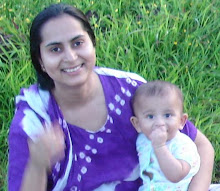Goa's breadmaking traditions
Goan PAV
By
Melinda Pereira Kamat
Christians all over the world pray to God everyday asking Him to give them their daily bread. Goans are still nostalgic about the suriche pav available in Goa during the Portuguese rule. The original Goan breads are pav, pokso or pokshi [ called undo by the locals], poyi, katrya pav, revdo, godd poyi and kakon. Bread making requires skill , use of proper measurements and temperature. Pokso requires a temperature of above 250 degrees celcius for baking. A cut is made in between the dough ball so that it bakes properly from inside and puffs up. It should have a crisp upper crust just like the broon available in Mumbai and Pune. Poyi is made from whole wheat flour with the other ingredients just like pav and rolled like a puri and no sugar is used in the dough. At times after making puri it is rolled in bran [kundo] . Revdo has got concentric circles. Katrya pav has a H shape. Kneaded flour balls are cut with a knife to give a particular shape and then with the edge of the little finger and palm it is pulled without exerting pressure. Godd poyi has more sugar content . Kakon is shaped like a bangle . Dough prepared for kakon is kneaded very tough with very less water and baked above 250 degrees. The ingredients used for pav, pokso, katrya pav, revdo , kakon are the same. To prepare the typical Goan pav select superior quality , superfine maida in which more than 10% gluten is present. If the gluten content is less then 10% then the bread is hard on the inside. For ½ kg maida use 1 wati of lukewarm milk and not boiling hot milk. The first step is to mix thoroughly till it dissolves, then add 1 heaped teaspoon of fresh yeast , 4 teaspoons of sugar in lukewarm milk with a sprinkling of little maida . Sugar gives it a reddish brown colour during the process of baking. This is kept for 10 minutes so that it ferments and starts frothing.. Only fresh or wet yeast is used as it contains active yeast cells. Yeast should never be kept outside the refrigerator as it looses its power to ferment. Then add this flying ferment to ½ kg of maida and little salt. Salt adds flavour and helps the dough to puff up during baking. At this stage it is important to be gentle with the flour . Knead it with only the tips of the fingers , add clean water and 1 tbsp of oil. Do not press the dough or else it will not ferment . The dough should be loose , firm and kept closed for 1 hour. Bakers in Goa keep dough for 2 hours for fermentation in a tank made of cement called konbi. After 1 hour knead the dough that has risen and has become porous. At this stage knead it nicely with 1 tbsp of oil , till it is elastic with a glaze. Take a well greased tray and keep the dough balls on it leaving some space between . Let it rest for 20 minutes. Do not overferment the dough. After 20 minutes preheat the oven , keeping the temperature at 225degrees celcius and keep the tray with dough balls inside . The tray is kept very gently without shaking it. Bakers bake bread in traditional stone ovens called khorn or forn. When the colour of bread becomes golden brown remove it from the oven and brush the top portion with a mixture of ghee and oil. Keep it for 2-3 minutes so that it gets a glaze. Do not keep the bread in the electric oven after it is switched off because the steam inside will soften the bread. Traditional bakers remove bread from the oven with a long shovel called hoorpone . A perfect pav resembles a honeycomb from inside having thin cell walls , with a golden brown crust on the outside. Instead of using maida if whole wheat flour is used then it is called brown bread . The rest of the procedure is the same like maida bread. Dietitians advice eating brown bread as it is nutritious. To prepare suriche pav add fresh toddy , sugar and mix with whole wheat flour. Bread is eaten with masala tonak, batat bhaji, ambot tik , kalchi kodi , atoili kodi etc. Leftover bread could be made into breadcrumbs or fatyo.
skip to main |
skip to sidebar

Melinda Pereira Kamat, Goa's young Food anthropologist and popular food columnist discusses the great culinary heritage of Goa (India) based on her own research and practical experience
Followers
Blog Archive
About Me

- Mrs. Melinda Pereira Kamat
- Goa, India
- An agricultural scientist and a teacher by profession with deep interest in food ethos of India and Goa